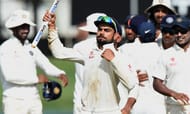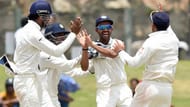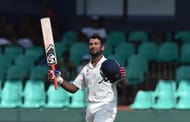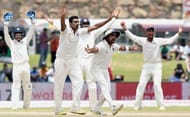A jubilant Indian Test team celebrate with the trophy after defeating Sri Lanka 2-1In recent history, one cannot fault the average Indian cricket fanatic for frequently escaping into a world of past glories, reminiscing about the age-old days when three absolute legends Sachin Tendulkar, Rahul Dravid and VVS Laxman regularly turned out for the Indian Test team.As MS Dhoni’s Test team leapfrogged from one series defeat to another, especially in overseas conditions, the cricket lover from India found it difficult to accept the lack of fight and intent shown by the young Indian team.Looking back, it seems aeons ago when the Indian batting stalwarts last shared a stage together, stitching memorable partnerships and piling on the runs, in a bid to outwit the opposition. Statistically speaking, it has been only 33 months since the first member of this famed triplet, Dravid, bid adieu, yet each defeat garnered abroad after their absence, made one feel that the golden days attained under them, was a thing of the long, lost bygone era.The fact that India last won a Test series away from home way back in 2011, when Laxman, Tendulkar and Dravid were a part of the national set-up, enhanced their legacy even further, as Test cricket in India declined to newer lows.4 years and 63 days after the last series triumph on West Indian shores, a new age aggressive breed of cricketers managed to create history on the Emerald Isle, by capturing their first series win in the nation after a gap of 22 years.Seen as a litmus test for skipper Virat Kohli, who took over the reins from Dhoni earlier this year, the Delhiite’s first full series as Test captain was defined by a breed of cricket, which had not been witnessed under Dhoni. Overcoming a 0-1 deficit for only the third time in the history of Indian cricket, the visitors stood out for their teamwork and commitment, which helped them grab the series 2-1.Here are 5 positives for India from this series, which spells good news for the country, going ahead into the 4 match Test series against South Africa, scheduled later this year.
#5 Kohli\'s aggressive captaincy

If there is one word you would not have associated with Kohli until a year ago, it would have been ‘calm.’
After the first Test match, which India was guilty of losing despite being in a comprehensive position for a major part of the five days, Kohli was criticised for being over aggressive when conditions and situations demanded a calm approach.
Switch over to the second and third matches and a different Kohli took the field. A Kohli who was proactive, yet defensive when needed, without letting the match slip away from his grasp.
The Delhiite should be praised for his ability to play according to the conditions. Any other captain would have been tempted to bowl Ashwin and Mishra, India’s most successful bowlers in the series straight up at the SSC, yet Kohli allowed his faster bowlers to reap the benefits, and they did not disappoint.
His bowling changes need special mention. During the first Test match, when Chandimal was going hammer and tongs and with the new ball due in 5 overs, Kohli preferred to rotate his bowlers every over.
Playing the patient game while awaiting the new ball might not have paid off in the particular match, but his intent of not allowing the batsman to get comfortable with a particular bowler with the hard ball, is praiseworthy.
By playing five bowlers, he had the option of giving shorter spells to his faster bowlers, keeping them refreshed in the process. He constantly kept catch-in fielders for spinners and on occasions, Binny even bowled to a field comprising three slips. Kohli’s brand of cricket is a far cry from Dhoni’s passive defensiveness.
By encouraging Ishant to go all out in fury while bowling, Kohli has surely marked the beginning of an era where the Indians will not hesitate to get under the skin of the opposition. Even though he has his areas to improve, the early glimpses witnessed have been refreshing to say the least.
Yet, for the critics who term Kohli a selfish and a brash captain, one need not look further than the guard of honour his team meted out to Sangakkara during the second Test match as he came out to bat in both the innings.
This act, more than anything, indicates how Kohli the captain, who does not want to lose at any cost, is vastly different from Kohli the individual who still has his virtues and respect for the legends intact and alive.
#4 Catching by the close-in fielders

Ajinkya Rahane not only shone with the bat in this series. The Mumbaikar was also slowly gaining the reputation of being one of the best catchers in the Indian team, when he created a world record for picking up 8 catches in the first Test match at Galle.
After the retirements of Laxman and Dravid, the best slip fielders in the Indian team for long, Dhoni had a tough time finding their replacements. By constantly shifting the fielders in the slip cordon, the players were not able to get used to each other, often dropping easy sitters due to lack of concentration and attention.In the England tour last year, five fielders were tried in the slip cordon, with eight catches being spilt.
Rahane, given tips by Dravid, was a treat to watch at the slip cordon. His catch todismiss Lahiru Thirimanne, where he managed to hold on to the ball inches short of the ground, even though it went fine and not wide to his left as he had anticipated, displayed his excellent balance, reflexes and his alert stance.
Rahane pulled off a stunner when he caught Sangakkara in the second innings at Galle, divingto his left to take a low one-handed catch off the bowling of Ashwin, after the ball had turned considerably.
Rahul and Pujara at short leg gave adequate support to the bowlers with to their fielding, stopping the singles with their agility and coming close to pulling off tight run out chances, piling on the pressure on the batsmen.
#3 Contribution from every member

The ability to see every chance as an opportunity rather than a difficulty, in the words of Kohli, was a major reason for the team’s success on the Sri Lankan shores after 22 long years. Cricket, a game which needs significant contributions from all members, witnessed an all-round effort from the Indian Test squad, with the players chipping in whenever the team seemed in dire states.
Shikhar Dhawan and Virat Kohli’s centuries in the 1st innings at Galle, which also included a partnership of 227 runs for the fourth wicket, warded off the threat presented by the Sri Lankan attack after the fall of early wickets, thus helping the team overcome Sri Lanka’s score of 183. Wriddhiman Saha, looking to push India’s lead further in the same innings, made a fighting knock of 60; which had grit and determination written all over.
Ajinkya Rahane’s match winning hundred after Kohli pushed him up the order to number 3 in the second match so that Rohit Sharma could find his footing lower down the order, spoke of his selflessness and the ability to adapt to any circumstances.
Refusing to show discomfort on facing the new ball, Rahane, combining with Murali Vijay, led India to a comprehensive win, helping India level the series 1-1. KL Rahul, who donned the wicket-keeping gloves in place of injured Saha in the second innings, scored a century in the first innings as well.
The biggest applause, however, should be reserved for Cheteshwar Pujara, who had lost favour in the Test team after a poor showing in 2014, with Rohit being preferred over the Saurashtrian.
Coming into play as an opener in the 3rd test after regular openers Vijay and Dhawan suffered injuries, Pujara became only the fourth Indian and first player since David Warner achieved the feat in 2011 to carry his bat through an innings, scoring a valiant 145 on a seaming wicket.
As others collapsed around him, Pujara’s technique and skills provided the perfect foil to Kohli’s aggressiveness, which helped India notch up a competitive first innings score. After garnering a lead of 111 and with the rain threatening to play spoilsport, it was imperative that the Indian batsmen score quick runs in their 2nd innings, to give ample time to the bowlers to defend the score.
Rohit, Stuart Binny, debutant Naman Ojha, Amit Mishra and Ashwin all chipped in with handy contributions, scored at a brisk pace to take the lead to 375.
Even in the bowling front, Binny, in the 1st innings of the third Test and Umesh Yadav in the 2nd innings of the second Test showed their mettle by bowling economically and consistently.
They might not have the wickets to show against their names, but their tight bowling, along with the performances of Ishant, Ashwin and Mishra, ensured that the players were unable to rotate the strike, which further frustrated the batsmen.
The performance by every member of the team is seen as a welcome departure from the instances when only an individual had rallied around for his team without any support from the other members (remember how Dravid was the lone warrior in England in 2011?). The competitive bench strength, more than anything, is what spells good news going forward.
#2 Mishra\'s emergence as the second spinner

The very fact that Sri Lanka went against their strengths to create a green pitch at the SSC, long considered a fortress for the Lankans, after the annihilation received by Ravichandran Ashwin in the preceding Test matches, gives an indication of the impact the off-spinner had on the opposition.
Ashwin accounted for Kumar Sangakkara, who retired from international cricket after the second Test match, on all 4 occasions, cleverly deceiving him with the turn on offer.
He picked up 21 wickets in the series, the highest haul by any Indian bowler in Sri Lanka, including a 10-wicket match haul in the first Test at Galle. For critics who claimed that his performances came in friendly turning pitches with considerable bounce, one need not look further than Harbhajan Singh, who failed to replicate his old magic, capturing only two wickets in the first Test match, after which he was dropped from the squad, with leg-spinner Amit Mishra partnering Ashwin in the next two games.
Mishra, drafted back into the team for the first time since 2011, proved to be the perfect foil to Ashwin, scalping 15 wickets in the series. He weaved his magic with the ball, deceiving the batsmen with his googlies and by being slow through the air – an art still held in high regard by the old fashioned leg spinners.
His dismissal of Dinesh Chandimal in the 2nd innings of the second Test, where he bowled the batsman with the ball drifting around his pads on the leg side stands out for special mention.
Even in a pitch that assisted the fast bowlers at the SSC, Mishra picked up three wickets and could have dismissed Angelo Mathews leg before wicket when the Sri Lankan was batting in his nineties, if not for a glaring decision by umpire Nigel Llong.
Mishra proved more than handy with the bat as well, notching up 157 runs in the series, becoming only the first Indian to claim 15 wickets and score 150+ innings in a three-match Test series.
With Ravinder Jadeja and Bhajji not performing as expected, and Pragyan Ojha remedying a suspect action, the 32-year-old looks all set to play the Test series against South Africa, where he is sure to get more purchase from the wickets.
#1 Ishant Sharma finally becomes the pace spearhead

Ishant Sharma was seen as the successor to Zaheer Khan after an impressive tour to Australia in 2007-08, where he constantly troubled the opposition skipper Ricky Ponting with his seam bowling and his ability to get the ball to rise.
The lanky 6-feet 4-inch bowler, termed a “dangerous bowler” by the Aussie, however, lost the plot henceforth by developing an inconsistent line and length. Accused of bowling all over the wicket and easing off the pressure after leaking runs from his end, the promising youngster inched towards a career average of 40.
The Sri Lanka series, however, saw a rejuvenated Ishant take the field, bowling his heart out even in unfriendly conditions in the second Test match, pioneering India to a historic series win. In the last one year alone, Ishant has 4 five wicket hauls, with figures of 6/51 and 6/134 against New Zealand, along with his spirited 7/74 at Lord’s last year, besides his figures earlier this week.
A major improvement in his bowling has been his uptight wrist position while releasing the ball, which has enabled the ball to swing more. By bowling a fuller length with a shortened run-up, Ishant kept a tight line and length, which drew the batsman forward out of his crease.
Twelve of his thirteen scalps in this series were a result of the batsmen holding out the delivery to the close-in fielders, a fair indication of Ishant’s persistence with a consistent line.
He conceded only a single boundary in his 19 overs in the last innings at the SSC, very different from his former pedestrian self. Ishant was a delight to watch with the new ball in hand and even though he failed to touch the 140 km/hr mark regularly, he showed enough glimpses of the promising youngster that had taken the field Down Under in 2007.
During the course of his 8-wicket match haul in the third Test, Ishant became only the fourth Indian paceman, after Kapil Dev, Javaganal Srinath and Zaheer Khan to pick up 200 wickets. Although it came after a long wait of 65 matches, the signs given in the last one year have been encouraging.
Even though he bowled a whopping 25 no balls in the 6 innings, there is no taking away credit from the lion-hearted performance even with the old ball, which failed to provide much assistance.
The Indian team management would hope that the experienced Ishant continues to dish out match winning performances even with the SG ball, where the shine vanishes after 10 overs, as opposed to the Kookaburra used in Sri Lanka, where the ball swings for at least 20 overs.
Follow IPL Auction 2025 Live Updates, News & Biddings at Sportskeeda. Get the fastest updates on Mega-Auction and cricket news
